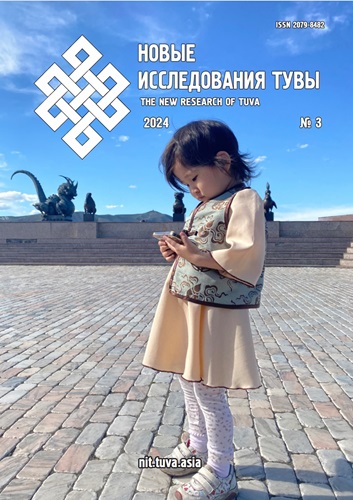The severity of anxiety-depressive states and somatization in adolescents and youth with different online behaviors in Tuva
DOI:
https://doi.org/10.25178/nit.2024.3.8Keywords:
Tuva; teenager; youth; online behavior; Tuvans; Russians; anxiety; somatization; depressionAbstract
The article analyzes the issues of the psycho-emotional state of adolescents and young people in the Republic of Tuva, who differ in the types of internet use: adaptive, maladaptive, and pathological. The study was based on the results of an online survey conducted by random sampling in 2023, including 1028 participants: 76 Russians and 952 Tuvans. To assess the psychological well-being of the individuals involved in the study, the SCL-90-R questionnaire was used, which identifies nine different symptoms. Three of these symptoms were analyzed: anxiety, depression, and somatization, which reflect the distress caused by feelings of physical discomfort.
A comparative analysis of indicators among groups differing in online behavior and ethnicity is presented. The Russian part of the sample, regardless of the online behavior variant, was characterized by higher levels of somatization (28.9% of Russians and 24.4% of Tuvans), depression (20% and 11.9%), and anxiety (25.4% and 12.1%).
Differences were also revealed among representatives of the compared ethnic groups with similar online behavior. Among both Russians and Tuvans with a pathological use of the Internet, higher levels of somatization, anxiety, and depression were more common. Ethnic differences manifested in a higher number of people with high somatization and depression levels in the Russian group with adaptive online behavior compared to the Tuvan group with similar behavior. Anxiety levels were more frequently observed among Russian adolescents and young adults with a pathological online behavior pattern (71.4% and 28.6%).
References
Bogomolova M. A. and Buzina T. S. (2018) Internet addiction: forming aspects and psychological correction opportunities. Meditsinskaia psikhologiia v Rossii, no. 2 [online] Available at: http://mprj.ru/archiv_global/2018_2_49/nomer02.php (access date: 01.04.2024). (In Russ.).
Buduk-ool, L. K. (2013) Features of adaptation to the education of students of the Republic of Tuva. Ekologiia cheloveka, no. 5, pp. 54–60. (In Russ.).
Voiskunskii A. E. (2015) Theories of addiction and presence related to behavior on the Internet. Meditsinskaia psikhologiia v Rossii, no. 4 [online] Available at: http://mprj.ru/archiv_global/2015_4_33/nomer07.php (access date: 01.04.2024). (In Russ.).
Dugarova, T. Ts. (2015) Features of stress resistance of Buryat and Tuvan teenagers. Vestnik Tuvinskogo gosudarstvennogo universiteta, Sotsial'nye i gumanitarnye nauki, no. 1, pp. 133–136. (In Russ.).
Kekeeva, Z. O., Uvarova, G. N., Darzhinova, S. V., Mueva, A. V. and Oorzhak, A. B. (2022) Research on the network identity of the student youth of Russian regions (the cases of Kalmykia and Tuva). New Research of Tuva, no. 4, pp. 169–179. (In Russ.). DOI: https://doi.org/10.25178/nit.2022.4.13
Korolenko, Ts. P. and Dmitrieva, N. V. (2001) Psychosocial addictology. Novosibirsk, Olsib. 251 p. (In Russ.).
Korolenko, Ts. P. and Loskutova, V. A. (2004) Internet addiction in the Russian-speaking Internet sector. Biulleten' Sibirskogo otdeleniia Rossiiskoi akademii meditsinskikh nauk, no. 3 (113), pp. 45–51. (In Russ.).
Lamazhaa, Ch. K. (2021) Social Culture of Tuvans and Online Space. New Research of Tuva, no. 2, pp. 115–129. (In Russ.). DOI: https://doi.org/10.25178/nit.2021.2.10
Lanovaia, A. M. and Fadeeva, E. V. (2021) Prevalence of electronic communication devices problematic use among adolescents and young adults in the Russian Federation. Voprosy psikhicheskogo zdorov'ia detei i podrostkov, vol. 21, no. 2, pp. 96–104. (In Russ.).
Lifintseva, A. A. and Zhivotiagin, R. R. (2012) The relation between characteristics of social networks of adolescents and the level of their psychosomatic health. Clinical Psychology and Special Education, vol. 1, no. 2 [online] Available at: https://psyjournals.ru/journals/cpse/archive/2012_n2/52619 (access date: 01.04.2024). (In Russ.).
Makarova, E. A. (2023) Self-harming behavior of children and adolescents on the Internet. Vestnik Taganrogskogo instituta upravleniia i ekonomiki, no. 1, pp. 49–55. (In Russ.).
Malygin, V. L. Merkur'eva, Iu. A., Iskandirova, A. B., Pakhtusova, E. E. and Prokof'eva, A. V. (2015) Specific features of value orientations in adolescents with Internet addictive behaviour. Meditsinskaia psikhologiia v Rossii, no. 4 (33) [online] Available at: http://mprj.ru/archiv_global/2015_4_33/nomer02.php (access date: 01.04.2024). (In Russ.).
Mikhal'chenko, V. Iu. (2015) The language situation and language policy in modern Russia. In: The linguistic situation in Europe at the beginning of the XXI century : collection of reviews / ed. by N. N. Troshin. Moscow, s. n. 179 p. Pp. 14–31.
Permiakova, E. Iu., Batsevich, V. A., Krasil'nikova, V. A., Zimina, S. N., Khafizova, A. A., Iudina, A. M., Iasina, O. V., Kliniushin, A. A. and Sineva, I. M. (2022) A comparison of morphofunctional adaptation of student youth in Kyzyl and Moscow (under different ethical and environmental conditions). New Research of Tuva, no. 1, pp. 237–252. (In Russ.). DOI: https://doi.org/10.25178/nit.2022.1.16
Semenova, N. B., Tereshchenko, S. Iu., Evert, L. S., Zaitseva, O. I. and Shubina, M. V. (2020) Prevalence of Internet addiction among adolescents in Central Siberia. Zdravookhranenie Rossiiskoi Federatsii, vol. 64, no. 1, pp. 36–44. (In Russ.).
Soldatova, G. U. and Iliukhina, S. N. (2021) Self-destructive online content: features of attitude and response of adolescents and youth. Konsul'tativnaia psikhologiia i psikhoterapiia, vol. 29, no. 1, pp. 66–91. (In Russ.).
Solodnikov, V. V. and Zaitseva, A. S. (2021) Usage of Social Networks and Socialization of Russian Teenagers. Sociologicheskaja nauka i social’naja praktika, vol. 9, no. 1, pp. 23–42. (In Russ.). DOI: https://doi.org/10.19181/snsp.2021.9.1.7870
Trusova, A. V., Grechanyi, C. V., Pozdniak, V. V., Il'ichev, A. B., Khutorianskaia, Iu. V., Egorov, A. Iu. and Kibitov, A. O. (2019) Psychological risk factors for internet addiction: findings of a pilot investigation in healthy young adults. Sotsial'naia i klinicheskaia psikhiatriia, vol. 29, no. 3, pp. 23–29. (In Russ.).
Trusova, A. V., Grechanyi, S. V., Soldatkin, V. A., Iakovlev, A. N., Iliuk, R. D., Chuprova, N. A., Nikolishin, A. E., Ponizovskii, P. A., Kibitov, A. A., Vantei, V. B. Et al. (2020a) Internet addiction predictors: analysis of psychological factors. V. M. Bekhterev review of psychiatry and medical psychology, no. 1, pp. 72–82. (In Russ.). DOI: https://doi.org/10.31363/2313-7053-2020-1-72-82
Trusova, A. V., Kanashov, A. E., Angelovskii, A. A., Varakosova, E. L., Zhidkova, T. S., Safonova, A. V., Lukmanova, Z. G., Berdetskikh, E. I., Abramets, M. A. and Peskisheva, L. Iu. (2020b) Gender differences in individual psychological characteristics of adolescents with different levels of internet addiction symptoms. Voprosy narkologii, no. 4, pp. 45–62. (In Russ.).
Turakaev, M. S. (2022) Ethno-linguistic situation as a factor in the social well-being of the Republics of Russia: the cases of Tuva, Bashkortostan and Kalmykia). New Research of Tuva, no. 2, pp. 70–84. (In Russ.). DOI: https://doi.org/10.25178/nit.2022.2.5
Shakun, E. Iu., Lanovaia, A. M. and Fadeeva, E. V. (2022) Addiction and Problematic Internet Use among Girls and Young Women: Prevalence, Main Features and Measures (A Review of Russian Studies). Counseling Psychology and Psychotherapy, vol. 30, no. 2, pp. 45–66. (In Russ.). DOI: https://doi.org/10.17759/cpp.2022300204
Evert, L. S., Tereshchenko, S. Iu., Zaitseva, O. I., Semenova, N. B. and Shubina, M. V. (2020) Internet addiction in adolescents in Central Siberia: analysis of prevalence and structure of consumed content. Bulletin of Siberian Medicine, vol. 19, no. 4, pp. 189–197. (In Russ.). DOI: https://doi.org/10.20538/1682-0363-2020-4-189-197
Evert, L. S., Seren-ool S. S. and Sat, D. A. (2023) Teenagers of Kyzyl (Republic of Tuva) in the online space]. New Research of Tuva, no. 4, pp. 237–254. DOI: https://doi.org/10.25178/nit.2023.4.17
Bohland, H. K, Kimbel, R., Kegel, P., Dietz, P., Koestner, C., Letzel, S., Kurmeyer, C., Jesuthasan, J., Schouler-Ocak, M. and Zier, U. (2024) Depression and anxiety in female refugees from East Africa and the Middle East displaced to Germany: cross-sectional results of the female refugee study, taking sociodemographic and migration-related factors into account. Frontiers in Psychiatry, vol. 14, article 1303009. DOI: https://doi.org/10.3389/fpsyt.2023.1303009
Carli, V., Durkee, T., Wasserman, D., Hadlaczky, G., Despalins, R., Kramarz, E., Wasserman, C., Sarchiapone, M., Hoven, CW., Brunner, R. and Kaess, M. (2013) The association between pathological internet use and comorbid psychopathology: a systematic review. Psychopathology, vol. 46, issue 1, pp. 1–13. DOI: https://doi.org/10.1159/000337971
Chen, S.-H., Weng, L.-J., Su, Y.-J., Wu, H.-M. and Yang, P.-F. (2003) Development of a Chinese Internet Addiction Scale and Its Psychometric Study. Chinese Journal of Psychology, vol. 45, no. 3, pp. 279–294. DOI: https://doi.org/10.1037/t44491-000
de Wit, M. A., Tuinebreijer, W. C., Dekker, J., Beekman, A. J., Gorissen, W. H., Schrier, A. C., Penninx, B. W., Komproe, I. H. and Verhoeff, A. P. (2008) Depressive and anxiety disorders in different ethnic groups: a population based study among native Dutch, and Turkish, Moroccan and Surinamese migrants in Amsterdam. Social Psychiatry and Psychiatric Epidemiology, vol. 43, pp. 905–912. DOI: https://doi.org/10.1007/s00127-008-0382-5
Doh, Y. Y., Kim, B., Lee, S. and Gweon, G. (2020) The Cyclic Value-Context Reinforcement Model of Problematic Internet Use: Empirical Validation Using a Thematic Analysis of Children’s Counseling Data. Journal of Medical Internet Research, vol. 22, no. 7, articel e17996. DOI: https://doi.org/10.2196/17996
Dreher, A., Hahn, E., Diefenbacher, A., Nguyen, M. H., Böge, K., Burian, H., Dettling, M., Burian, R. and Ta, T. M. T. (2017) Cultural differences in symptom representation for depression and somatization measured by the PHQ between Vietnamese and German psychiatric outpatients. Journal of Psychosomatic Research, vol. 102, pp. 71–77. DOI: https://doi.org/10.1016/j.jpsychores.2017.09.010
Durkee, T., Kaess, M., Carli, V., Parzer, P., Wasserman, C., Floderus, B., Apter, A., Balazs, J., Barzilay, S., Bobes, J., Brunner, R., Corcoran, P., Cosman, D., Cotter, P., Despalins, R., Graber, N., Guillemin, F., Haring, C., Kahn, J. P., Mandelli, L., Marusic, D., Mészáros, G., Musa, G. J., Postuvan, V., Resch, F., Saiz, P. A., Sisask, M., Varnik, A., Sarchiapone, M., Hoven, C. W. and Wasserman, D. (2012) Prevalence of pathological internet use among adolescents in Europe: demographic and social factors. Addiction, vol. 107, issue 12, pp. 2210–2222. DOI: https://doi.org/10.1111/j.1360-0443.2012.03946.x
Fam, J. Y. (2018) Prevalence of internet gaming disorder in adolescents: A meta-analysis across three decades. Scandinavian Journal of Psychology, vol. 59, issue 5, pp. 524–531. DOI: https://doi.org/10.1111/sjop.12459
Fanny, M. (1982) Cheung Psychological symptoms among Chinese in urban Hong Kong. Social Science & Medicine, vol. 16, issue 14, pp. 1339–1344. DOI: https://doi.org/10.1016/0277-9536(82)90029-6
Fatemeh, F., Sadeghian, E., Shamsaei, F. and Tapak, L. (2020) The relationship between internet addiction and psychosomatic disorders in Iranian undergraduate nursing students: a cross-sectional study. Journal of Addictive Diseases, vol. 38, issue 2, pp. 164–169. DOI: https://doi.org/10.1080/10550887.2020.1732180
Feng, W., Ramo, D., Chan, S. and Bourgeois, J. A. (2017) Internet gaming disorder: Trends in prevalence 1998–2016. Addictive Behaviors, vol. 75, pp. 17–24. DOI: https://doi.org/10.1016/j.addbeh.2017.06.010
Hoge, E. A., Tamrakar, S. M., Christian, K. M., Mahara, N., Nepal, M. K., Pollack, M. H. and Simon, N. M. (2006) Cross-cultural differences in somatic presentation in patients with generalized anxiety disorder. The Journal of Nervous and Mental Disease, vol. 194 (12), pp. 962–966. DOI: https://doi.org/10.1097/01.nmd.0000243813.59385.75
Hsu, L. K. and Folstein, M. F. (1997) Somatoform disorders in Caucasian and Chinese Americans. The Journal of Nervous & Mental Disease, vol. 185(6), pp. 382–387. DOI: https://doi.org/10.1097/00005053-199706000-00004
Jeong, B., Lee, J. Y., Kim, B. M., Park, E., Kwon, J. G., Kim, D. J., Lee, Y., Choi, J. S. and Lee, D. (2020) Associations of personality and clinical characteristics with excessive Internet and smartphone use in adolescents: A structural equation modeling approach. Addictive Behaviors, vol. 110, article 106485. DOI: https://doi.org/10.1016/j.addbeh.2020.106485
Jeong, H., Lee, H. K., Kwon, Y. S., Yim, H. W. and Lee, S. Y. (2020) Gaming disorder and bidirectional relationships with aggression and impulsivity. Current Opinion in Behavioral Sciences, vol. 31, pp. 69–75.
Kaess, M., Durkee, T., Brunner, R., Carli, V., Parzer, P., Wasserman, C., Sarchiapone, M., Hoven, C., Apter, A., Balazs, J., Balint, M., Bobes, J., Cohen, R., Cosman, D., Cotter, P., Fischer, G., Floderus, B., Iosue, M., Haring, C., Kahn, J. P., Musa, G. J., Nemes, B., Postuvan, V., Resch, F., Saiz, P. A., Sisask, M., Snir, A., Varnik, A., Žiberna, J. and Wasserman, D. (2014) Pathological Internet use among European adolescents: psychopathology and self-destructive behaviours. European Child Adolescent Psychiatry, vol. 23, no. 11, pp. 1093–1102. DOI: http://dx.doi.org/10.1007/s00787-014-0562-7
Kaess, M., Parzer, P., Mehl, L., Weil, L., Strittmatter, E., Resch, F. and Koenig, J. (2017) Stress vulnerability in male youth with Internet Gaming Disorder. Psychoneuroendocrinology, vol. 77, pp. 244–251. DOI: https://doi.org/10.1016/j.psyneuen.2017.01.008
King, D. L., Delfabbro, P. H., Zwaans, T., et al. (2013) Clinical features and axis I comorbidity of Australian adolescent pathological Internet and video game users. Australian & New Zealand Journal of Psychiatry, vol. 47, pp. 1058–1067. DOI: https://doi.org/10.1177/0004867413491
Kirmayer, L. J. (2001) Cultural variations in the clinical presentation of depression and anxiety: implications for diagnosis and treatment. Journal of Clinical Psychiatry, vol. 62, issue 13, pp. 22–28; discussion 29–30.
Ko, C. H., Yen, J. Y., Chen, C. S., Chen, C. C. and Yen, C. F. (2008) Psychiatric comorbidity of internet addiction in college students: an interview study. CNS Spectrums, vol. 13, issue 2, pp. 147–153. DOI: https://doi.org/10.1017/s1092852900016308
Ko, C. H., Yen, J. Y., Yen, C. F., Chen, C. S. and Chen, C. C. (2012) The association between Internet addiction and psychiatric disorder: a review of the literature. European Psychiatry, vol. 27, issue 1, pp. 1–8. DOI: https://doi.org/10.1016/j.eurpsy.2010.04.011
Kuss, D. J. and Griffiths, M. D. (2015) Internet Addiction: A Real Addiction? In: Internet Addiction in Psychotherapy. Palgrave Studies in Cyberpsychology. Series Ed. J. Binder. London, Palgrave Pivot. P. 54–104. DOI: https://doi.org/10.1057/9781137465078_4
Kuss, D. J., van Rooij, A. J., Shorter, G. W., Griffiths, M. D. and van de Mheen, D. (2013) Internet addiction in adolescents: Prevalence and risk factors. Computers in Human Behavior, vol. 29, issue 5, pp. 1987–1996. DOI: https://doi.org/10.1016/j.chb.2013.04.002
Kuss, D. J., Shorter, G. W., van Rooij, A. J., van de Mheen, D. and Griffiths, M. D. (2014) The Internet addiction components model and personality: Establishing construct validity via a nomological network. Computers in Human Behavior, vol. 39, pp. 312–321. DOI: https://doi.org/10.1016/j.chb.2014.07.031
Mak, K. K., Lai, C. M., Watanabe, H., Kim, D. I., Bahar, N., Ramos, M., Young, K. S., Ho, R. C., Aum, N. R. and Cheng, C. (2014) Epidemiology of internet behaviors and addiction among adolescents in six Asian countries. Cyberpsychology, Behavior, and Social Networking, vol. 17, issue 11, pp. 720–728. DOI: https://doi.org/10.1089/cyber.2014.0139
Missinne, S. and Bracke, P. (2012) Depressive symptoms among immigrants and ethnic minorities: a population based study in 23 European countries. Social Psychiatry and Psychiatric Epidemiology, vol. 47, issue 1, pp. 97–109. DOI: https://doi.org/10.1007/s00127-010-0321-0
Munno, D., Cappellin, F., Saroldi, M., Bechon, E., Guglielmucci, F., Passera, R. and Zullo, G. (2017) Internet Addiction Disorder: Personality characteristics and risk of pathological overuse in adolescents. Psychiatry Research, vol. 248, pp. 1–5. DOI: https://doi.org/10.1016/j.psychres.2016.11.008
Müller, K. W., Janikian, M., Dreier, M., Wölfling, K., Beutel, M. E., Tzavara, C., Richardson, C. and Tsitsika, A. (2015) Regular gaming behavior and internet gaming disorder in European adolescents: Results from a cross-national representative survey of prevalence, predictors, and psychopathological correlates. European Child & Adolescent Psychiatry, vol. 24, pp. 565–574. DOI: https://doi.org/10.1007/s00787-014-0611-2
Müller, K. W., Dreier, M., Duven, E., Giralt, S., Beutel, M. E. and Wölfling, K. (2017) Adding Clinical Validity to the Statistical Power of Large-Scale Epidemiological Surveys on Internet Addiction in Adolescence: A Combined Approach to Investigate Psychopathology and Development-Specific Personality Traits Associated with Internet Addiction. Journal of Clinical Psychiatry, vol. 78, issue 3, articlt e244-e251. DOI: https://doi.org/10.4088/JCP.15m10447
Nissen, A., Cauley, P., Saboonchi, F., Andersen, A. and Solberg, Ø. (2021) Mental health in adult refugees from Syria resettled in Norway between 2015 and 2017: a nationwide, questionnaire-based, cross-sectional prevalence study. European Journal of Psychotraumatology, vol. 12, issue 1, article 1994218. DOI: https://doi.org/10.1080/20008198.2021.1994218
Özaslan, A., Yildirim, M., Güney, E., Güzel, H. and Işeri, E. (2022) Association Between Problematic Internet Use, Quality of Parent-Adolescents Relationship, Conflicts, and Mental Health Problem. International Journal of Mental Health and Addiction, vol. 20, pp. 2503–2519. DOI: https://doi.org/10.1007/s11469-021-00529-8
Peterka-Bonetta, J., Sindermann, C., Elhai, J. D. and Montag, C. (2019) Personality Associations with Smartphone and Internet Use Disorder: A Comparison Study Including Links to Impulsivity and Social Anxiety. Frontiers in Public Health, vol. 7, article 127. DOI: https://doi.org/10.3389/fpubh.2019.00127
Rachubińska, K., Cybulska, A., Szkup, M. and Grochans, E. (2021) Analysis of the relationship between personality traits and Internet addiction. European Review for Medical and Pharmacological Sciences, vol. 25, no. 6, pp. 2591–2599. DOI: https://doi.org/10.26355/eurrev_202103_25422
Rask, S., Suvisaari, J., Koskinen, S., Koponen, P., Mölsä, M., Lehtisalo, R., Schubert, C., Pakaslahti, A. and Castaneda, A. E. (2016) The ethnic gap in mental health: A population-based study of Russian, Somali and Kurdish origin migrants in Finland. Scandinavian Journal of Public Health, vol. 44, issue 3, pp. 281–290. DOI: https://doi.org/10.1177/1403494815619256
Rumpf, H. J., Achab, S., Billieux, J., Bowden-Jones, H., Carragher, N., Demetrovics, Z., Higuchi, S., King, D. L., Mann, K., Potenza, M., Saunders, J. B., et al. (2018) Including gaming disorder in the ICD-11: The need to do so from a clinical and public health perspective. Journal of Behavioral Addictions, vol. 7, issue 3, pp. 556–561. DOI: https://doi.org/10.1556/2006.7.2018.59
Schimmenti, A., Passanisi, A., Caretti, V., La Marca, L., Granieri, A., Iacolino, C., Gervasi, A. M., Maganuco, N. R. and Billieux, J. (2017) Traumatic experiences, alexithymia, and Internet addiction symptoms among late adolescents: A moderated mediation analysis. Addictive Behaviors, vol. 64, pp. 314–320. DOI: https://doi.org/10.1016/j.addbeh.2015.11.002
Shapira, N. A., Goldsmith, T. D., Keck, P. E. Jr., Khosla, U. M. and McElroy, S. L. (2000) Psychiatric features of individuals with problematic internet use. Journal of Affective Disorders, vol. 57, issue 1–3, pp. 267–272. DOI: https://doi.org/10.1016/s0165-0327(99)00107-x
Stevens, M. W., Dorstyn, D., Delfabbro, P. H. and King, D. L. (2021) Global prevalence of gaming disorder: A systematic review and meta-analysis. Australian & New Zealand Journal of Psychiatry, vol. 55, issue 6, pp. 553–568. DOI: https://doi.org/10.1177/0004867420962851
Stiglic, N. and Viner, R. M. (2019) Effects of screentime on the health and well-being of children and adolescents: a systematic review of reviews. BMJ Open, vol. 9, issue 1, article e023191. DOI: https://doi.org/10.1136/bmjopen-2018-023191
Tao, R., Huang, X., Wang, J., Zhang, H., Zhang, Y. and Li, M. (2010) Proposed diagnostic criteria for internet addiction. Addiction, vol. 105, issue 3, pp. 556–564. DOI: https://doi.org/10.1111/j.1360-0443.2009.02828.x
Yen, J. Y., Ko, C. H., Yen, C. F., Chen, S. H., Chung, W. L. and Chen, C. C. (2008) Psychiatric symptoms in adolescents with internet addiction: comparison with substance use. Psychiatry and Clinical Neurosciences, vol. 62, issue 1, p. 9–16. DOI: https://doi.org/10.1111/j.1440-1819.2007.01770.x
Young, K. S. (2013) Treatment outcomes using CBT-IA with Internet-addicted patients. Journal of Behavioral Addictions, vol. 2, no. 4, pp. 209–215. DOI: https://doi.org/10.1556/jba.2.2013.4.3
Zhou, X., Dere, J., Zhu, X., Yao, S., Chentsova-Dutton, Y. E. and Ryder, A. G. (2011) Anxiety symptom presentations in Han Chinese and Euro-Canadian outpatients: is distress always somatized in China? Journal of Affective Disorders, vol. 135, issue 1–3, pp. 111–114. DOI: https://doi.org/10.1016/j.jad.2011.06.049
Published
How to Cite
For citation:
Fotekova T. A., Vlasova E. N., Mitrukhina S. V. and Mongush Ch. N. The severity of anxiety-depressive states and somatization in adolescents and youth with different online behaviors in Tuva. New Research of Tuva, 2024, no. 3, pp. 136‑158 (In Russ.). DOI: https://doi.org/10.25178/nit.2024.3.8
Issue
Section

This work is licensed under a Creative Commons Attribution-NonCommercial 4.0 International License.

Author(s) license holder(s) grant rights for their work to the journal (grantee of a license) under the simple non-exclusive open license in accordance with Art. 1286.1 «Open license for a research work, work of literature or fine arts», Civil Code of the Russian Federation.
New Research of Tuva publishes articles under the Creative Commons Attribution-NonCommercial license (CC BY-NC).
Since it is an open license, author(s) reserve the right to upload the article to their institutional repository, submit it to another journal (if it allows republications), or republish it on their own website (in full, or in part).
However, several conditions apply here:
a) The republished version must always contain the name(s) and affiliation(s) of the author(s), the original title and the hyperlink to the original version on the New Research of Tuva website;
b) It must be in open access, free of charge, and no category of readers must be in any way whatsoever advantaged over general readership.
c) should the contribution be submitted elsewhere by its author(s) without substantial modification (30% or more of original text unchanged), the body of the article should contain a disclaimer that the original version was published in New Research of Tuva (with a link to the respective page)
The CC-BY-NC is a non-revocable license which applies worldwide and lasts for the duration of the work’s copyright.












